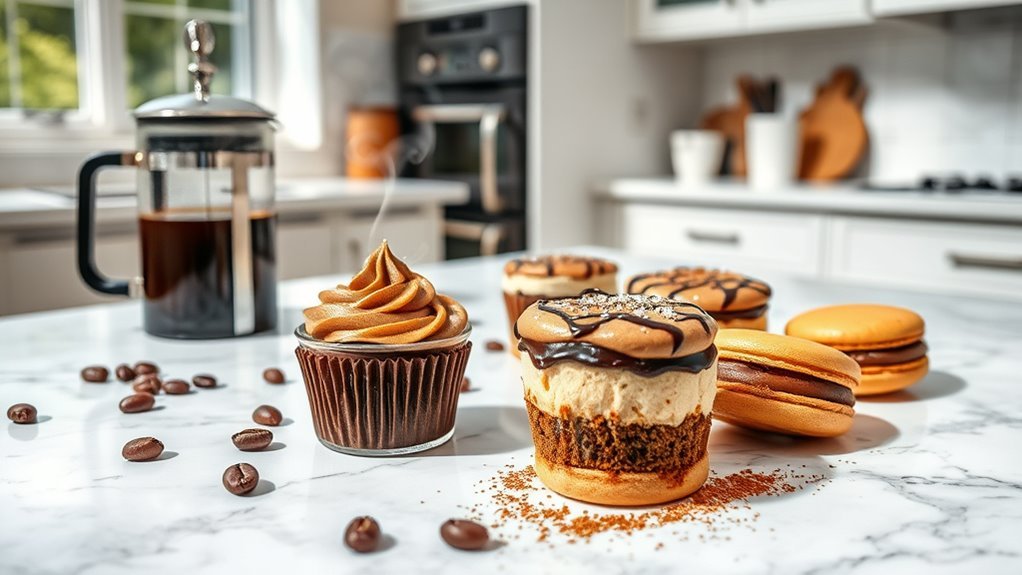How to Make Coffee Infused Desserts
To make coffee-infused desserts that truly sing, start by choosing coffee with a flavor profile that matches your treat—deep roasts for chocolatey richness or bright, fruity beans for lighter sweets. Brew carefully to control strength and bitterness, then incorporate espresso, cold brew, or coffee syrups into batters, creams, or toppings. Balance coffee’s boldness with sweetness and add texture with nuts or whipped cream. Master these steps, and you’ll reveal layers of complex flavor waiting to be explored.
Choosing the Right Coffee for Your Desserts

How do you pick the perfect coffee to elevate your dessert? Start by exploring coffee flavor profiles—each bean carries unique notes like fruity brightness, chocolate undertones, or nutty warmth. These nuances aren’t just for sipping; they transform dessert pairings. For a rich chocolate cake, opt for a coffee with deep, roasted flavors to complement the cocoa. Light, citrusy coffees enhance fruity desserts, adding a revitalizing zing. Don’t overlook medium roasts, which balance acidity and sweetness, perfect for creamy treats like tiramisu. By matching the intensity and character of coffee to your dessert, you reveal a symphony of flavors that dance on your palate. Freedom in your kitchen means experimenting boldly, trusting your taste buds to guide a harmonious coffee-dessert union.
Brewing Techniques to Enhance Flavor
Although selecting the right coffee is essential, mastering brewing techniques can reveal even deeper flavors for your desserts. Start by controlling the brewing temperature—aim for water between 195°F and 205°F to extract ideal taste without bitterness. Next, adjust your grind size to suit your brewing method; a finer grind works well for espresso, while a coarser grind suits French press. This balance influences the coffee’s strength and clarity, revealing nuanced notes that’ll elevate your dessert’s complexity. Don’t be afraid to experiment—tweak the grind size and brewing temperature until you find a profile that harmonizes perfectly with your sweet creation. By refining these elements, you’re not just making coffee; you’re crafting a flavor foundation that lets your desserts truly sing.
Incorporating Coffee Into Baked Goods
When you add coffee to baked goods, the type of coffee you choose shapes the final flavor, from bright and fruity to deep and smoky. Brewing methods matter too—espresso concentrates boldness, while cold brew offers smooth, mellow notes that blend seamlessly into batters. Picking the right combination lets you craft desserts with rich, layered coffee profiles that elevate every bite.
Choosing Coffee Types
Since the flavor of your dessert hinges on the coffee you choose, selecting the right type is essential for achieving a balanced, rich taste. Understanding espresso origins and roast profiles will guide you to the perfect match. Dark roasts bring bold, smoky notes that elevate chocolate desserts, while medium roasts offer a sweet, nutty character ideal for creamy treats. Light roasts add bright, fruity nuances that brighten delicate pastries. Consider these options:
- Single-origin espresso for unique, vibrant flavors
- Dark roast for deep, intense coffee notes
- Medium roast for balanced sweetness and aroma
- Light roast to highlight subtle fruity undertones
- Blends to create a harmonious flavor profile
Your freedom to explore these choices will transform your coffee-infused creations into unforgettable experiences.
Brewing Methods for Baking
Choosing the right coffee sets the foundation, but how you brew it will shape the final flavor and texture in your baked goods. If you want a bold, concentrated coffee essence, espresso shots are your go-to. Their intense, rich flavor blends seamlessly into batters, adding depth without extra moisture. For a smoother, less acidic taste, cold brew is perfect—it infuses desserts with subtle coffee notes and a velvety texture, ideal for cakes and frostings. Remember, the brewing method influences not just taste but consistency; espresso’s strength lets you use less liquid, while cold brew can replace some of your recipe’s wet ingredients. Experiment with these techniques, and you’ll reveal a world where coffee’s complexity enhances every bite, giving you freedom to craft truly unforgettable desserts.
Using Coffee in Creamy Desserts
When adding coffee to creamy desserts, you’ll want to select a coffee type that complements the richness without overpowering it. Mastering infusion techniques—whether through espresso shots, brewed coffee, or coffee extracts—helps you weave that bold flavor smoothly into your dessert’s texture. Finally, balancing the coffee’s bitterness with sweetness and creaminess guarantees every bite hits just the right note.
Choosing Coffee Types
Although any coffee can bring a rich flavor to creamy desserts, selecting the right type is key to balancing bitterness and sweetness. You’ll want to explore espresso varieties known for their bold, concentrated essence, perfect for cutting through rich creams. Alternatively, coffee blends crafted from different beans can add nuanced complexity and smoothness. When choosing, consider the roast level and origin—they affect acidity and depth, shaping your dessert’s character.
- Dark espresso varieties for intense, smoky notes
- Medium roasts in coffee blends for balanced flavor
- Single-origin beans for unique aroma profiles
- Light roasts to highlight floral, fruity undertones
- Decaffeinated options preserving flavor without the buzz
This mindful selection frees you to craft desserts that sing with coffee’s vibrant soul.
Infusing Techniques
Once you’ve picked the perfect coffee to match your dessert’s mood, the next step is weaving that flavor seamlessly into your creamy creations. Start by stirring espresso powder directly into sugar or cocoa powder—this quick method releases bold, concentrated notes without watering down texture. For a cooler, smooth infusion, fold cold brew into custards or whipped creams; its mellow, rich character blends effortlessly, adding depth without bitterness. When heating creams or milk, gently steep finely ground coffee, then strain thoroughly to avoid grit, ensuring a silky finish. Each technique lets you control intensity and texture, giving your desserts that unmistakable coffee essence. Experiment with these methods to infuse your creamy desserts with freedom and flair, crafting indulgences that awaken senses and elevate every bite.
Balancing Flavors
Because coffee carries both bitter and aromatic qualities, you’ll need to carefully balance its intensity with the sweetness and creaminess of your dessert. Mastering this interplay lets you craft rich flavor profiles that elevate each bite. To do this, consider how coffee’s boldness contrasts with smooth textures and sugary notes, creating a harmonious dance on your palate.
When balancing flavors in creamy desserts, keep these in mind:
- Use sweeteners like honey or brown sugar to soften bitterness
- Incorporate vanilla or caramel to deepen aromatic layers
- Adjust coffee strength to match dessert richness
- Add a pinch of salt for enhanced taste contrasts
- Experiment with cream types for varying mouthfeel
Embrace freedom in flavor exploration, blending coffee’s complexity without overpowering your dessert’s delicate creaminess.
Coffee Syrups and Sauces for Toppings

Two essential coffee syrups and sauces can transform your desserts from ordinary to extraordinary by adding rich, aromatic layers of flavor. When choosing your coffee syrup, consider coffee flavor intensity and syrup consistency—it should be thick enough to drizzle but fluid enough to blend seamlessly. Coffee caramel syrup offers a smooth, buttery sweetness with a velvety consistency, while espresso chocolate sauce delivers a bold, bitter edge with a glossy finish. Here’s a quick guide:
| Syrup Type | Coffee Flavor Intensity | Syrup Consistency |
|---|---|---|
| Coffee Caramel | Mild | Thick, smooth |
| Espresso Chocolate | Strong | Medium, glossy |
| Vanilla Coffee | Balanced | Light, pourable |
Master these toppings, and your desserts will echo the freedom of bold, rich coffee notes.
Balancing Coffee With Sweetness and Texture
While coffee brings a distinct bitterness and depth to desserts, you’ll want to carefully balance it with sweetness and texture to create a harmonious bite. Mastering sweetness ratios guarantees your dessert isn’t overly sharp or cloying. Pairing coffee’s boldness with the right texture contrasts enhances every mouthful, making flavors pop and inviting you to savor each layer.
Consider these techniques to achieve balance:
- Use creamy elements like mascarpone or whipped cream for softness.
- Incorporate crunchy nuts or biscotti for crisp texture contrasts.
- Adjust sugar levels to complement coffee’s natural bitterness.
- Add moisture with syrups or soaked cake layers for tenderness.
- Blend smooth chocolate or caramel to marry sweetness and depth.
Creative Coffee Dessert Recipe Ideas
Once you’ve mastered balancing coffee’s bold flavors with sweetness and texture, you’re ready to explore inventive dessert recipes that highlight coffee’s unique character. Immerse yourself in desserts that celebrate varied coffee flavor profiles—from fruity Ethiopian beans to smoky Sumatran roasts. Experiment with classic and unexpected dessert pairings to reveal new dimensions of taste.
| Coffee Flavor Profile | Ideal Dessert Pairing | Flavor Impact |
|---|---|---|
| Bright & Fruity | Lemon Tarts | Enhances citrus notes |
| Rich & Chocolatey | Dark Chocolate Mousse | Amplifies depth |
| Earthy & Spicy | Chai-Spiced Brownies | Adds warmth and spice |
With these combos, you’re not just making desserts—you’re crafting experiences that awaken senses and spark freedom in flavor.
Tips for Storing and Serving Coffee-Infused Treats

Because coffee-infused desserts carry delicate flavors and aromas, proper storage is essential to preserve their complexity and freshness. When storing your treats, keep them airtight and cool to retain that rich coffee essence. Here are some storing tips and serving suggestions to elevate your experience:
- Wrap desserts tightly in plastic wrap or store in sealed containers
- Refrigerate creamy or mousse-based treats promptly
- Bring chilled desserts to room temperature before serving to reveal flavors
- Garnish with fresh coffee beans, cocoa powder, or whipped cream for a visual and aromatic boost
- Pair with a complementary brew, like a light roast, to enhance contrasts
Frequently Asked Questions
Can I Use Instant Coffee for Desserts Instead of Brewed Coffee?
You definitely can use instant coffee in desserts instead of brewed coffee. Instant coffee benefits include its convenience and concentrated flavor, which lets you control the intensity easily. Plus, instant coffee flavors tend to be bold and consistent, making them perfect for infusing into sweets. You’ll save time without sacrificing taste, giving you the freedom to experiment and create rich, coffee-infused treats with less hassle and more delicious results.
How Does Caffeine Content Affect Dessert Recipes?
Did you know the average cup of coffee packs about 95 mg of caffeine? When you add caffeine to desserts, its effects can subtly influence the final texture—sometimes making it denser or slightly drier. You’ll want to balance caffeine effects carefully; too much could overwhelm flavors or alter moisture levels, changing how your dessert feels. So, tweak your recipe thoughtfully to keep that perfect, indulgent texture you crave.
Are There Coffee Substitutes Suitable for Coffee-Infused Desserts?
If you want to skip traditional coffee but keep that rich, earthy vibe in your desserts, chicory root and mushroom coffee are perfect substitutes. Chicory root offers a deep, slightly bitter flavor that mimics coffee’s robustness without caffeine. Mushroom coffee blends earthy mushroom extracts with roasted beans, giving you a mellow, complex taste. Both let you craft unique, caffeine-free treats that don’t compromise on depth or character—freedom to experiment with flavor awaits!
Can Coffee Desserts Be Made Vegan or Dairy-Free Easily?
Absolutely, you can easily make coffee desserts vegan or dairy-free. By swapping traditional ingredients with vegan alternatives like coconut cream, almond milk, or oat-based products, you maintain rich, creamy textures without dairy. Dairy-free options don’t compromise flavor; instead, they reveal new layers of taste and freedom in your dessert-making. Embrace plant-based substitutes to create indulgent coffee treats that align perfectly with your lifestyle and dietary choices.
What Are the Best Coffee Pairings With Wine or Liqueurs?
Pairing perfect potions, you’ll find coffee flavor profiles flourish with fruity, floral dessert wine combinations like Muscat or Riesling. Rich, robust roasts resonate remarkably with dark, decadent liqueurs such as Kahlúa or Frangelico, enhancing hazelnut and chocolate notes. If you crave crisp, citrusy coffee, try pairing it with a zesty, sweet limoncello. Embrace experimentation—your freedom to fuse flavors lets you discover divine, delightful dessert duets.






